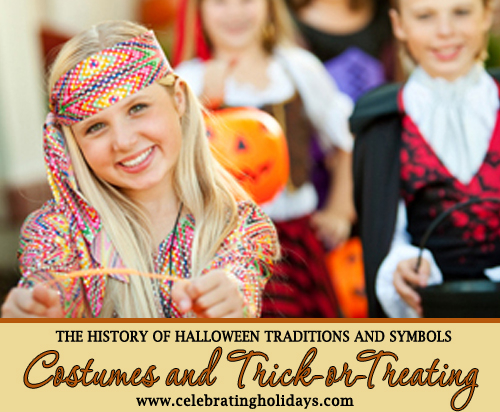Costumes (and Trick-or-treating)
This page offers a brief history, from a Christian perspective, of costumes and trick-or-treating as a Halloween symbols, images, and traditions.
NOTE: This information is drawn from a Rose Publishing pamphlet, Christian Origins of Halloween. The content has a copyright © 2012.

The strongest case for the origin of trick-or-treating in the U.S. comes from the British Isles:
The “Treat”
During Hallowmas (Oct. 31 – Nov. 2) in the pre-Reformation British Isles, there existed a popular tradition called “souling.” The poor would move from door to door asking for food and drink in return for a prayer for the dead (to relieve their souls of purgatorial punishment). It was common for households to give out baked bread or “soul cakes.” Other frequent gifts were apples, nuts, ale and coins.
Among Protestants, the Reformation largely brought an end to the practice of praying for souls in purgatory.* However, even in Protestant regions “souling remained an important occasion for soliciting food and money from rich neighbors” in preparation for the coming cold and dark months.1
It was common throughout the British Isles for people to go “souling” in disguise. In some regions, the costumed visitors might even conduct a mini-play for homeowners that portrayed local legends or religious themes. Furthermore, churches throughout greater Europe celebrated All Saints’ Day with “processions in which parishioners dressed up as saints, angels and devils”2 — the common theme being that, in the end, evil was defeated by good. These traditions were probably the predecessors of our modern Halloween costumes.
The “Trick”
According to one historian, “Goblins, imps, fairies and trolls were thought to do a lot of mischief on Halloween in the British Isles. . . . For centuries, anonymous mischief was expected on October 31.”3 As a result, Halloween night was a favorite for energetic youth who were fond of practical jokes and pranks — costumes helped to ensure their anonymity.
Another historian records:
“Doors were blocked with carts, or attacked with a fusillade of turnips. Ploughs and carts were carried off and hidden; gates were taken off their hinges and thrown into a neighboring ditch or pond; horses were led from the stables and left in the fields a few miles away.”4
In neighboring Ireland, “Halloween begging always involved a masquerade and some sort of good-natured bribe.”5 Such traditions were easily imported to North America, and it appears that the term “trick or treat” grew out of a friendly threat to play a prank on anyone who refused to give a treat.
This page was created by:

We welcome your ideas! If you have suggestions on how to improve this page, please contact us.
You may freely use this content if you cite the source and/or link back to this page. This content is drawn from Christian Origins of Halloween by Angie Mosteller. It has a copyright © 2012 by Rose Publishing Inc.
Sources:
1 Rogers, Nicholas. Halloween, From Pagan Ritual to Party Night. Oxford University Press, 2002, pp. 29-30.
2 Bannatyne, p. 9.
3 Bannatyne, p. 61.
4 McNeill, F. Marian. Halloween, Its Origin, Rites and Ceremonies in the Scottish Tradition. The Albyn Press, 1970, p. 37.
5 Bannatyne, p. 67.
*To better understand the association between Halloween, All Saints’ Day, All Souls’ Day and the Reformed view of purgatory, see our Halloween History page, as well as our Halloween and Reformation Day page.